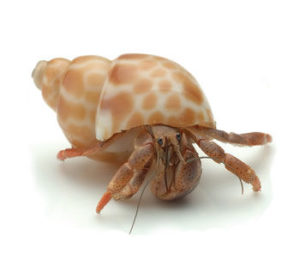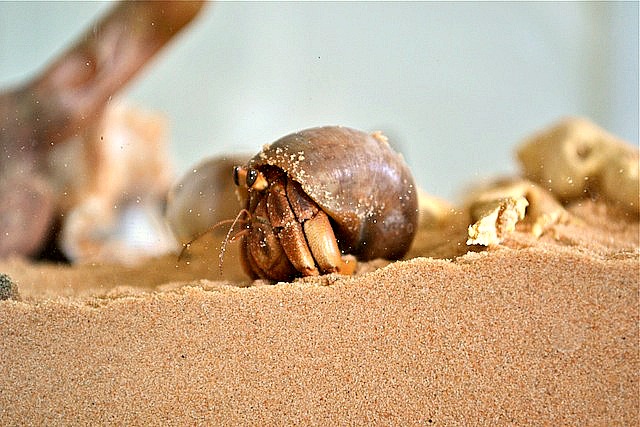Crazy Crabs

Crazy Crabs also known as Hermit Crabs, make the ideal pet for younger children. They are inexpensive, they don’t take up too much space, don’t smell if well kept and are easy to care for and feed. They are interesting to watch and will enjoy small amounts of “play time” outside of their housing, but please be sure to teach your children to handle them with care and always supervise during play time. Crazy Crab shells can be plain but at Pet City we also offer some beautiful and colourful hand painted shell to brighten up your enclosure.
Things you might need
- Terrarium or tank
- Suitable substrate
- Pet City Crab Chow
- Crab hut
- Food and water dish
- Crab salt
- Ornaments

Looking After Crazy Crabs
Housing
Crazy Crabs should be kept in a smooth sided container, such as a glass aquarium or plastic fish bowl or tank. They are expert climbers, wooden or cardboard containers are not suitable and the crabs will chew on wood and cardboard. Choose a container that suits the number of crabs you want to keep in it. Remember to make sure there is room enough for a food and water bowl as well as the crabs themselves. It’s no good having a small container where the crabs have to crawl through the food and water to move about.
On the bottom of the tank you can use aquarium gravel, beach sand, untreated wood shavings or river pebbles. The gravel or sand does not have to be deep as the crabs do burrow and you can’t see them if they are buried too deep. The floor needs to be kept dry as wet sand and high humidity can create a smelly and slimy environment for your crabs.
Crazy Crabs just love to climb and explore. Pieces of coral, sea sponge, driftwood, rocks and ceramic aquarium ornaments are all great for Crazy Crabs to play on. Make sure your decorations don’t lean onto the rim of their house, they are great climbers and can escape quickly. Next time you visit the beach see what treasures you can find for your crabs house.
Feeding
Provide a food and water dish for your crabs. Pet City Crab Chow is available from all our stores and provides the crabs with a well nutritionally balanced food source. Hermit crabs are natural scavengers so you cal also provide very small pieces of raw vegetable and meat daily to balance the diet. A little water dish serves two purposes, one is for drinking water and the other is to provide a small pool for the crabs to walk through, keeping their body moist when required. Hermit crabs drink fresh water but don’t use chlorinated tap water in the tank, boil it first and let it cool. Clean out food and water containers daily for optimum health.
Moulting and Shell Changes
As Crazy Crabs are crustaceans, they have their skeleton on the outside of their body, called an exoskeleton. In order to grow, once or twice a year, they shed this outer skeleton. Some crabs become sluggish and inactive when they are about to moult, others spend more time than usual in and around the water bowl. The crabs drink more water in order to make their body swell slightly in order to ‘crack’ their outer skin and this helps the skin to be discarded in a single piece. The crabs only shed the front half of their skin, as the back half is soft it is not covered by this hard outer skeleton.
When crabs moult, it is a very traumatic time for them, so you should take care not to touch them too much whilst they are moulting. After molting, the skin is usually left on the floor. You could be mistaken in thinking it is another crab. If you do find a skin, you can leave it there. Crabs will eat this skin as it is rich in calcium. They may eat this discarded old skin before you know they have actually moulted.
Crazy Crabs change shells throughout their lives as they grow. Growth is slow, around 1-2mm per year so spare shells should always be available just incase your crab needs a better fitting shell.
Handling
Crazy Crabs no matter what size, need to be handled with care. All crabs need to be placed on an open palm and allowed to walk from hand to hand. Don’t let your crab fall as this can cause injury and even death. Never dangle him by the shell, he can reach around and nip you on the finger as he is frightened and thinks you may drop him onto the floor. In the wild, birds pick them up and carry them away, so keep them on a steady open palm of your hand.
Crazy Crabs will usually only bite when they are frightened. It is more of a pinch than a bite and causes no damage to skin.
Larger crabs crawl quickly so handle them accordingly.
If your Crazy Crab does pinch you, lay your hand flat on the ground and let him crawl off. He will feel safe knowing you won’t drop him. Or you can run him under cool water instead.
